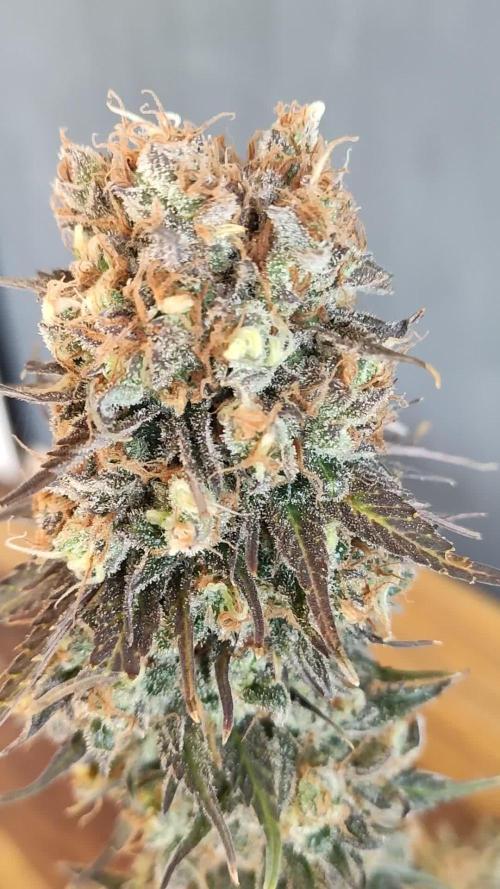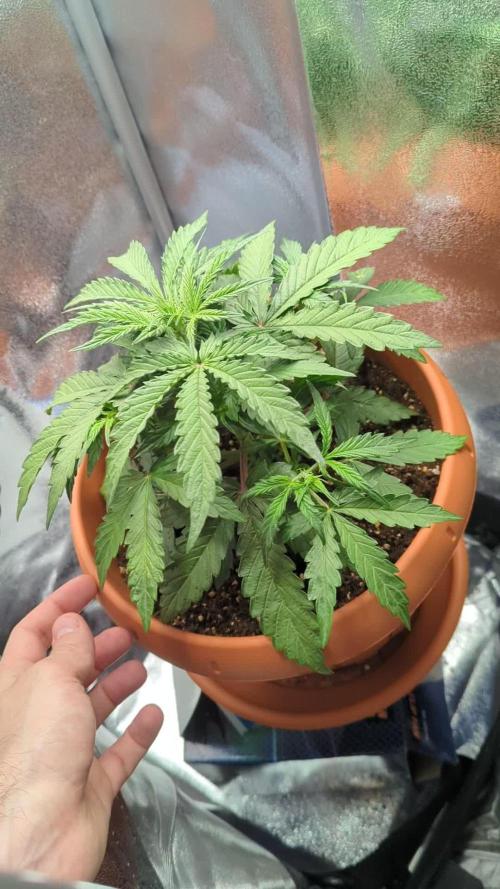The Grow Awards 2026 🏆 

































Likes
Comments
Share


@BB_UK
Follow
Ever since I turned to mars hydro I have double sometimes nearly quadrupled my yields I first had with eBay lights (meh) I have never looked back since and gained so much respect from the community and the breeders too! And to hold the sponsors I do shows me that I am doing something right and I show appreciation to all who support! And that’s why I take a different effort to be fair and document you all! Even though I’m aware your businesses I just can’t be bias when it comes to the greatest I think you all are! Thank you for choosing me! (No I’m not the only one) just showing the love back as best as I can! 💚💚💚💚💚 thank you
Likes
9
Share


@SkunkyDog420
Follow
Hallo zusammen 🤙
Habe sie heute geerntet.
Wir hören uns in 3 Wochen mit dem Erntebericht.
Likes
5
Share


@Mondolibero
Follow
Manca poco😰 ancora 3 settimane.....💚🌱💜🆓🇵🇸🇵🇸🆓le due auto ora sono nel barattolo di vetro a fare la concia...presto aggiungerò nuove foto.
Likes
3
Share


@KannaGrowing
Follow
Esta semana, poca cosa a añadir, tan solo que continuamos como la semana pasada.
Riegos alternos entre abono y agua, según tabla de fertilización de JUJU Royal by BioBizz.
Hemos aumentado la potencia de extracción para evitar olores.
Likes
62
Share


@DigiDom
Follow
Just keeping an eye on her for the time being. Looks like she has stopped stretching and is starting to fill out again. I'm just hoping the defoliation didn't slow her down too much.
Day 72 watered 3l
Day 72 Test Time Lapse
Day 74 watered 1.75l
Likes
21
Share


@reirrac1
Follow
Decided after seeing the improvement in the Tangerine Dream to continue with the new feeding schedule, which will include a flush in a few days. She got pretty burnt from the salt based nutes, but her flowers have thickened up considerable over the last few days so I will try to get as much out of her as possible. NCH x SB trichomes are finally beginning to fill out with milk, and several sugar leaves have already gone 30% amber. One more week of flushing and I think I’ll chop her down. Feed pH 6.5, EC 0.9. Flush pH 6.2, EC 0.3.
Processing
Likes
17
Share


@KrudBuddysExotics
Follow
Hey guys idk what’s going on my autos it seems as if the Gelato and Zkittlez has just stop growing completely I mean there’s no change at all the Zkittlez Og is starting to fill in forming nice little buds but my other autos seems like they had stop completely
I know the lifespan on the Gelato is 76-80 days from seed to harvest
The Zkittlez lifespan said the same 76-80 days from seed to harvest
Zkittlez Og lifespan is 80-90 days from seed to harvest
And I know I’m for sure March 9th marked the 60th day on all autos and I know I stress the hell out of them overwatered etc but it looks as if I might only have one plant to successfully make it yet this is my first grow and why I choose to do autos first to give me a little insight on what I’m doing but I’m going to let these girls go for a full 90 days before I decide to trash em and focus purely on my clone grows
Likes
129
Share


@DreamIT
Follow
🎲➕ VLC Critical Plus + by PEV Grow➕🎲
➕20.6 Quiet week start, I dry the soil well and tomorrow I start with the fertilizer, yeah!
➕21.6 All great, you see the changes day after day, really interesting 😁👊🦄
➕22.6 Everything is OK. Very fast, wide leaves for now, we are at the second node. a few days and mainlining begins 🤘
➕23.6 all regular, super yeah
➕24.6 even today nothing in particular to say, I can't wait to be able to manipulate it 😁🦄
➕25.6 It grows really well, very satisfied
➕26.6 All very well, tomorrow transfer next week or mid-week first cut, yeah!
__________________________________________
❓ Are you new to the world of cultivation and don't know where to safely buy your seeds?
😮On the Pevgrow site, you can find the best-feminized seeds indoors and outdoors. Achieved through totally natural stress methods and with guaranteed superior quality.
✅http://bit.ly/PevGrow
ℹ️Check out the marijuana dictionary
✅http://bit.ly/CannabisDictionaryPEVGrow
__________________________________________
👀 Are you looking for a good lamp to start with? 👀
🌞Viparspectra has something more than the others, take a look at their site.
⏩ Use "GDVIP" for an extra discount or "ViparDreamIT" for an extra 5 %% discount
👀 Search for it on Amazon
✅Amazon US: https://amzn.to/30xSTVq
✅Amazon Canada: https://amzn.to/38udUVe
✅Viparspectra UE: bit.ly/ViparspectraUE
👀 Watch my ViparSpectra XS1000 unboxing on YouTube, leave a like and write to the channel 🦄
✅http://bit.ly/UnboxingViparSpectraDreamIT
______________________________________________
📷🥇 Follow the best photos on Instagram 🥇📷
https://www.instagram.com/dreamit420/
🔻🔻Leave a comment with your opinion if you pass by here🔻🔻
🤟🦄💚 Thank you and enjoy the growth 💚🦄🤟
Likes
21
Share


@NSABND
Follow
Today start of week 10 (Day 70) 😎😵😏 with Trailer Park Mod 😂😂😂😂
i had old fans around here and a ice box, so i startet to build the 7 watts Trailer Park Fans Mod 😁😁😁
It´s Monday Day 71 and "Hilde" got another fertilizer shot today
from Day 72 to Day 75 i was on a Road Trip... 😳😎😳
Back from Road Trip and "Hilde" got another fertilizer shot today 😎👍😏
Likes
2
Share


@TTerpz
Follow
Fed with nutrients on 4/16/25
Watered with 6.8 ph plain water on 4/18/25
Day 5: fade began
4/20/25: fed with nutri
Likes
42
Share


@MrJoint
Follow
🍁Dicas e sugestões?
As meninas agradecem.
📸Update de fotos, vídeos e informações diariamente.
DAY 29
As meninas vão ficar alguns dias sem água até secar completamente suas raízes.
Agradeço @LaBossanova @Mr_Weeds_Autos pela dica do overwater. O diagnóstico ajudou muito!
DAY 30
Como é meu primeiro cultivo estou fazendo algumas experiências práticas para entender mais sobre a PLASTICIDADE FENOTIPICA e FISIOLOGIA DA PLANTA na prática.
Das 5 sementes:
✂️C1 e C3 parecem estar felizes com a poda e LST.
☀️C4 também está muito feliz morando na varanda, com o sol da manhã, me ajuda a observar o comportamento da planta na luz natural.
COP e C2 iniciarão as podas ainda esta semana...ou não😁estou tentando criar intimidade.
DAY 31
Terceiro dia sem regar as meninas.
Consertando o overwater.
Boa notícia: O calor foi embora e voltou a marcar 26°C no grow.
DAY 32
Após breve seca, as meninas receberam um pouco de água oxigenada para ajudar as raízes prejudicadas com o overwater.
DAY 33
Minhas garotas estavam com sede, ficaram felizes... Eu também!
Espero desta vez não errar na quantidade de água.
DAY 34
Aumentei o intervalo das regas. Acho que estou acertando.
DAY 35
As podas resultaram muito bem.
Ansioso pela próxima semana.
🎃Obrigado por verificar meu cultivo.
Processing
Likes
17
Share


@Tazard
Follow
We are nearing the end and she looks beautiful. I will flush with plain RO water the next week or two while she ripens. I didn’t do any training to her. I have a clone from her and I cut a few leaves from the top of the meristem when she was vegging and she responded with 6-8 branches catching up with the top.
Likes
11
Share


@BudBeezy
Follow
The plant tolerated the repotting well. The nutrient-rich soil has provided a good growth. As the pot is now larger, I have also increased the amount of watering. This week it will be watered every 2 days with about 350-400ml of rainwater. Last week I prepared a nettle manure to provide additional nitrogen fertiliser. As it has just been repotted, I won't be giving the fertiliser until next week.
The weather remains consistently good. The daytime temperature fluctuated between 19 and 24 degrees. The plant now also stays outside at night. I hope the weather stays as good as in the previous weeks.
Likes
15
Share


@Hypnogrow
Follow
I've pretty much been hands off this grow.
Just letting the plants do what they want.
I did a spray with insecticidal Soap which shocked some of the auto genetics. Had some leaf loss but they are bouncing back. I saw one tiny fly and wasnt worth the shock some of the susceptible plants had. Lesson learned.
I havent done much more than fimmed, topped, and lsted very lightly. Testing out fimming on autos. So far the lst only autos started flowering around day 23 to 25. The fimmed autos have stayed in veg much longer and were way more resilient. They are just starting to flower or show pistil. One of the Double Grape is showing completely different pheno than the other double grape. So much that I thought it might need 12/12 to flower. However it started showing pistils a day ago. Double grape responded very well to Fim and so did the northern lights big bud auto and purple scoops.
I had problems with a driver on a brand new fc3000 blowing up, mars hydro sent me a replacement driver. They then wanted to squabble about replacing the plastic piece that connects the driver to the light. Two weeks later they sent the part after I told them I had to buy an HLG cause I couldnt believe they wouldnt send me a plastic part.
Then the HLG I was sent was the 65 version not the 100 but they sent me the correct light right away and my plants and the clones loveeeed the HLG 100 v2. So much so that I bought the 65 version they sent by mistake and they gave me $10 bucks off for my troubles.
Even though I had to be persistent with Mars Hydro they did do me right and now both my LEDs are working. However I had a 4 by 8 of plants all stacked on one end under 150 watts for weeks trying to get this solved. I had multiple power and light issues with adding the new 4 by 8 tent that costs my plants I'm sure. I decided not to freak about it and let things go with the flow and not stress. Things will not be optimum but I learn each grow about my setup and this is my first grow in soil so learning curves.
I'm feeding very small amounts of calmag and seaweed extract in each watering which is every two to three days with ro water. I started this week three when the plants showed shock from the spray. It seemed to help them recover.
I'm using light warrior, ocean forest and living soil layered mix.
I kept 1 king tut, 3 alien tech clones which are doing good nice and rooted directly in light warrior. Transplanted week three in 3 gal pots.
Never cloned before so is a learning process.
Likes
15
Share


@I_Identify_As_A_Dan
Follow
Week 23 for Peyote Zkittlez by seedsman,
Not too much to report shes drinking a hell of a lot of water.. I do think she would have been in a bigger pot at this point you aren't even able to scratch the soil surface because its just roots.. 😂
So im hoping that doesn't effect her too badly can already tell that shes a little light on the nitrogen... May feed some FPJ to boost that up a little otherwise she may fade too early.
Likes
12
Share


@420DeepGrow
Follow
📆 Semana 4 - Permanent Jealousy XL Auto
Después de un mes con mal tiempo (lluvia, nubes y poca luz), la planta ha tenido un desarrollo lento, pero se mantiene sana. Actualmente tiene 3 nudos bien formados. A pesar de las condiciones, no ha mostrado signos de estrés severo ni deficiencias. A partir de ahora, con la mejora del clima, espero que empiece a acelerar el crecimiento.
Seguimos creciendo fuerte 💪!
Likes
8
Share


@oxieg3ngrows
Follow
This beauty has stolen my heart. She is so stinky and so pretty. I wish ya'll could share in this with me, as the flower is bound to be as amazing as growing her has been.

























